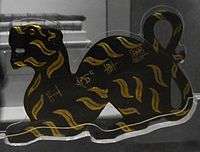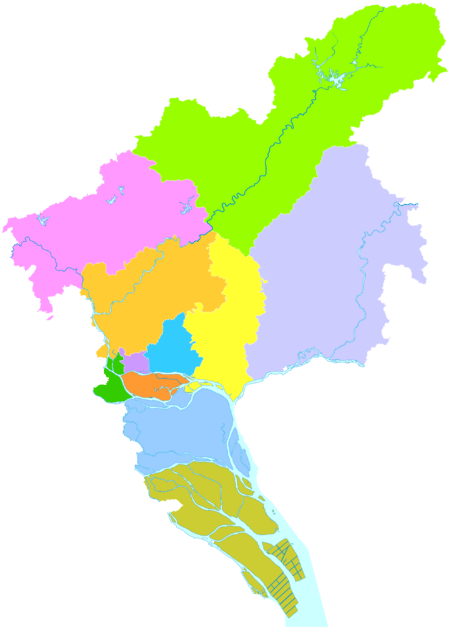Museum of the Mausoleum of the Nanyue King
Coordinates: 23°8′15″N 113°15′40″E / 23.13750°N 113.26111°E
| 西汉南越王博物馆 | |
|
| |
| Established | 1988 |
|---|---|
| Location | Guangzhou, China |
| Type | Mausoleum |
The Museum of the Western Han Dynasty Mausoleum of the Nanyue King (Chinese: 西汉南越王博物馆; pinyin: Xī Hàn Nányuè Wáng Bówùguăn; literally: "Western Han Nanyue King Museum") houses the 2,000-year-old tomb of the Nanyue King Zhao Mo in Guangzhou, China. Zhao Mo ruled from 137 BC to 122 BC, and his tomb was discovered in downtown Guangzhou in 1983. The museum, which opened in 1988, showcases the tomb and its complete trove of artifacts. It was named a Major National Historical Site in 1996 and is renowned for its rare assemblage of funerary artifacts representing the diffusion of cultures throughout the Lingnan region during the Han dynasty.
Layout
The mausoleum and museum complex occupies an area of 17,400 m2 (187,000 sq ft).[1] Hidden 20 meters (65.6 feet) underground, the tomb is made up of 750 huge stones with colorful murals. The over 1,000 pieces of cultural relics, bronzeware and terra cotta ware in particular, feature the Yue Culture of Lingnan (Nanyue Culture). Represented also are traces of central Chinese culture, the Chu culture of south China, the Bashu culture of southwest China, the culture from the northern grassland, and even foreign cultures.
The tomb was discovered in 1983 and the museum opened in 1988.[2] It is 20 meters under Xianggang Shan (Elephant Hill) in Guangzhou on a construction site for a hotel, and was excavated. The tomb is nearly 11 meters long and over 12 meters wide. It is divided in seven parts, with a front chamber, east and west wing rooms, the main coffin chamber, east and west side rooms, and a back storage chamber.
Artifacts

The tomb has yielded more than 1,000 burial artifacts, a chariot, gold and silver vessels, musical instruments, and human sacrifices were found (15 courtiers were buried alive with him to serve him in death). It is also among the only tombs of the early Western Han dynasty that has murals on its walls.
The tomb also excavated an imperial seal, belonging to that of "Emperor Wen" (Văn Đế), indicating that he considered himself equal in rank to the Han ruler. A bronze seal inscribed "Tư Phố hầu ấn" (Seal for Captain of Tư Phố County) was uncovered at Thanh Hoa in northern Vietnam during the 1930s.[3] Owing to the similarity to seals found at the tomb of the second king of Nam Viet, this bronze seal is recognized as an official seal of the Nam Viet Kingdom.
Alongside Chinese artifacts, pieces from the steppes, and Iranian and Hellenistic Central Asian regions have been found: a Persian silver box found in the tomb is the earliest imported product found to date in China. There were artifacts that were found in which belonged to the Đông Sơn culture of northern Vietnam.
A silk-jade garment made up of 2,291 pieces of jade is the spotlight of the mausoleum. It is acknowledged that jade garments with pieces connected by gold, silver, or copper are not uncommon. But this garment is unique for its jade pieces connected by silk which makes it the only one of its kind in the world. Nor are historical records available to verify other jade garments connected by silk thread. In addition, the style of buttons down the front is unique among unearthed jade garments. This silk-sewn-jade garment shows the early development of jade garments as well as development of the Nanyue culture.[4]
Access
The museum is located at 867 Jiefang Rd. in Yuexiu District in central Guangzhou.[1] It is accessible by bus routes 7, 29, 33, 203, 211, 273, 543, and 552, and by Metro Line 2 to the Yuexiu Park (Exit E).[1]
See also
References
- 1 2 3 (Chinese) 南博简介
- ↑ "Museum of the Western Han Dynasty Mausoleum of the Nanyue King". Retrieved 2008-02-14.
- ↑ "Thạp đồng Đông Sơn của Huyện lệnh Long Xoang (Xuyên) Triệu Đà". 2011-03-11.
Chiếc ấn đồng khối vuông “Tư (Việt) phố hầu ấn” có đúc hình rùa trên lưng được thương nhân cũng là nhà sưu tầm người Bỉ tên là Clement Huet mua được ở Thanh Hóa hồi trước thế chiến II (hiện bày ở Bảo tàng Nghệ thuật và Lịch sử Hoàng Gia Bỉ, Brussel) được cho là của viên điển sứ tước hầu ở Cửu Chân. Tư Phố là tên quận trị đóng ở khu vực làng Ràng (Thiệu Dương, Thanh Hóa) hiện nay.
- ↑ "History of Museum of the Western Han Dynasty Mausoleum of the Nanyue King". Retrieved 2008-02-14.
External links
| Wikimedia Commons has media related to Museum of the Western Han Dynasty Mausoleum of the Nanyue King. |
- Museum's official site(simplified Chinese)
